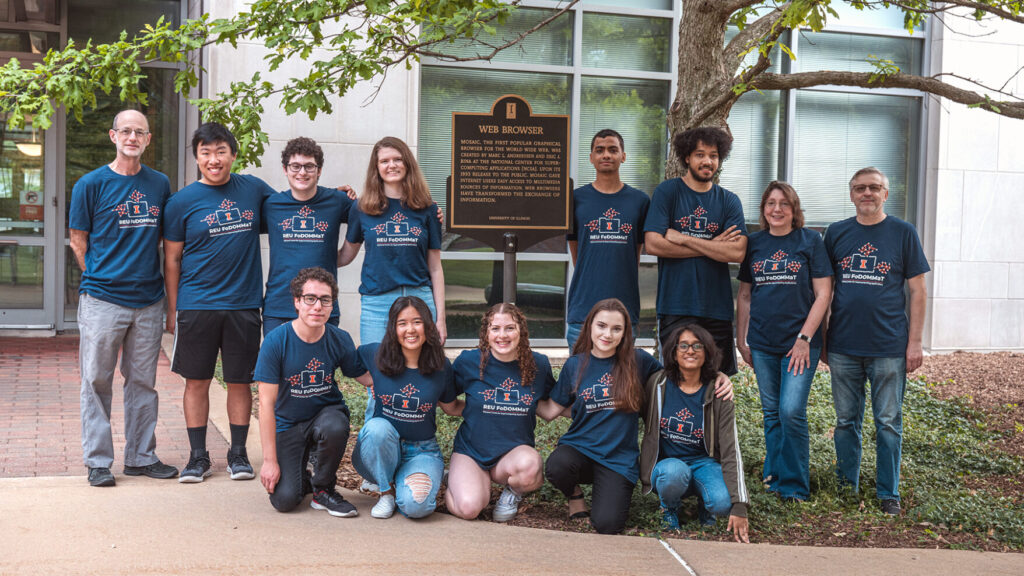At NCSA, important research is being done every day. Everything from working towards better cancer treatments to studying supernovae is included in NCSA’s portfolio of research projects. But NCSA doesn’t stop there. The Center also wants to help train and inspire future researchers. Through our many undergraduate student research opportunities, NCSA offers hands-on time with ongoing research with experts in their fields. The NCSA-funded Students Pushing Innovation (SPIN) and the National Science Foundation (NSF) -funded Research Experiences for Undergraduate (REU) programs both provide a one-of-a-kind experience for students interested in careers in research. By embedding REU and SPIN students in the projects, the students learn how research is conducted while working toward a research goal.
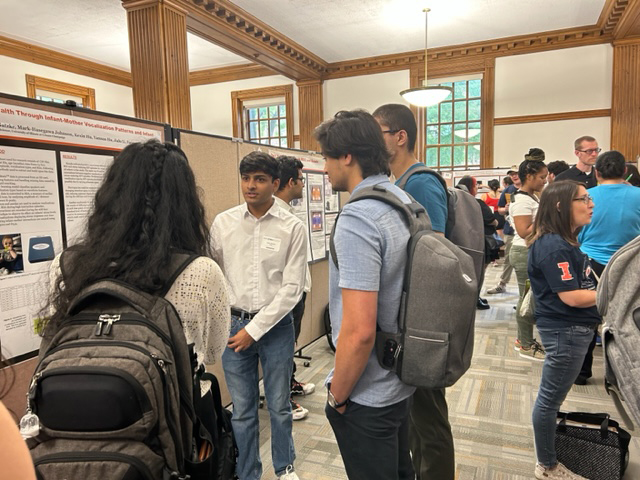
Being embedded on research teams isn’t the only opportunity available to SPIN and REU “The Future of Discovery: Training Students to Build and Apply Open-Source Machine Learning Models and Tools” (FoDoMMaT) students. NCSA interns and fellows are also encouraged to participate in professional development via conference attendance and participation. Students are supported by their mentors and the administrators of these programs, and funding for conference fees and materials is provided by NCSA. This year, students participated in the Grainger College of Engineering’s annual Engineering Open House, with SPIN students winning first place for their exhibit. SPIN and REU FoDoMMaT students also participated in the STEM Career Exploration and Symposium. As members of the Illinois Summer Research Programs Alliance (ISRPA), the students represented NCSA’s programs in a this summer’s event. The symposium had 120 student presenters across ISRPA and over 400 attendees. During the symposium, students engaged with 13 different industry partners and six professional organizations. They also reached out to 53 community college students and educators from across the state and helped them see the possibilities within the STEM field.
To understand how much value there is in these student opportunities at NCSA, it’s best to hear about these programs in the student’s own words. Here are just a few of the students and the projects they’ve worked on over the summer.
CHANCHARIK MITRA
Project: SPatial analysis of tumor heterogeneity using machine-Learning Techniques
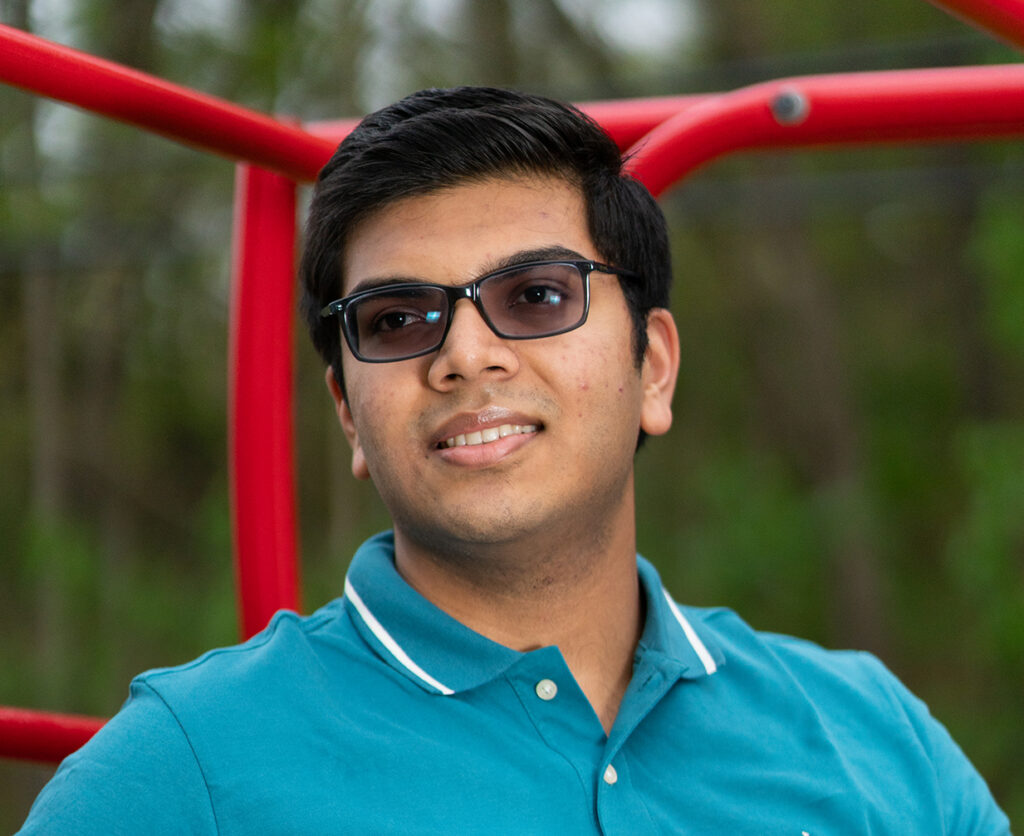
Chancharik Mitra is a fellow in the FoDOMMaT REU program. The FoDOMMaT program, now in its third year, has been highly successful at matching students with interesting research.
Mitra comes to NCSA from the University of California, Berkeley. He was keen to get more experience to help with his career aspirations. “I have always been passionate about research,” he said, “especially in computational biology as well as vision and language deep-learning models. My current goal is to pursue a Ph.D. and conduct research in understanding and fighting disease, as well as exploring vision and language methods to provide agents with high-level, compositional reasoning abilities.”
Mitra has been an REU fellow before. He was so impressed with the FoDOMMaT program last summer he applied for a second year to continue working on the project he started. “This is my second summer as an REU fellow at NCSA, having continued my research as a visiting scholar throughout the academic year.” Mitra’s project involves examining tumors at a micro level. Being able to understand the makeup of a tumor fully can help with more effective treatment.
As Mitra explains it, “Broadly, my research involves analyzing spatial transcriptomics data using statistical and machine-learning methods to gather insight into cancer. Aspects of cancer-omics research that are especially interesting to me include understanding cancer tumor heterogeneity and the impact of treatment on the spatial transcriptome of cancer tissue. My current work specifically deals with finding informative genes (called biomarkers) that can help further research, analysis, and treatment development for cancers.”
Each member of the research team is given tasks to work on – the students are treated as fully integrated members of the team, working alongside their mentors to reach their goal and, eventually, having their names included in any publications based on their work. Mitra is no exception, already having lead authorship on a paper titled Spatial Analysis of Tumor Heterogeneity Using Machine Learning Techniques. Mitra also presented the paper at a conference, earning him further experience and recognition.
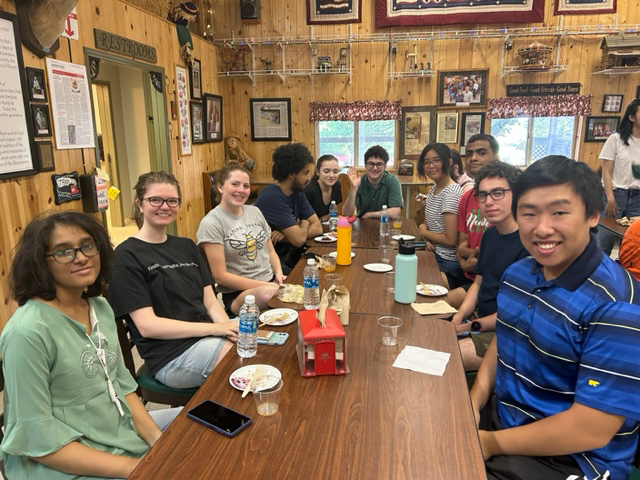
“My current goal is to develop an explainable pipeline for mining biomarkers related to cell and metabolic pathways significant for understanding cancer,” Mitra said. “Leveraging permutation importance feature extraction in combination with random forest classifiers and neural network methods, I am focusing on identifying biomarkers associated with the pathway of cell proliferation using liver-specific, metastatic ER+ breast tumors. I’m looking at not only finding relevant biomarkers but also extensively validating and explaining their importance as well, something quite novel in this space of work.”
Working on a project like this has helped illustrate how collaborative this type of research is. “As with most computational biology research, there is a lot of collaboration in our group!” Mitra said. “Put simply, the computational researchers in our group rely on the insight of biological researchers and vice-versa. I work closely with all members of the group who provide advice on interesting questions and directions to explore.”
Mitra has high praise for the program and says his application for a second year only proves how great an experience it’s been.
I can say with confidence that I have had a tremendously fruitful experience. The program is planned out meticulously by Mrs. Olena Kindratenko, with many opportunities to develop research skills as well as explore the eclectic variety of research being done at NCSA and UIUC more broadly. The mentorship I have received from my advisors, Dr. Aiman Soliman and Dr. Zeynep-Madak Erdogan, in research, presentations, and publications has been invaluable to me and has been an indelible part of my growth as a researcher.
Chancharik Mitra, REU fellow Tweet
HEATHER BROOME
Project: An integrated sensing, machine learning and high performance computing framework for real-time decision-making in smart manufacturing
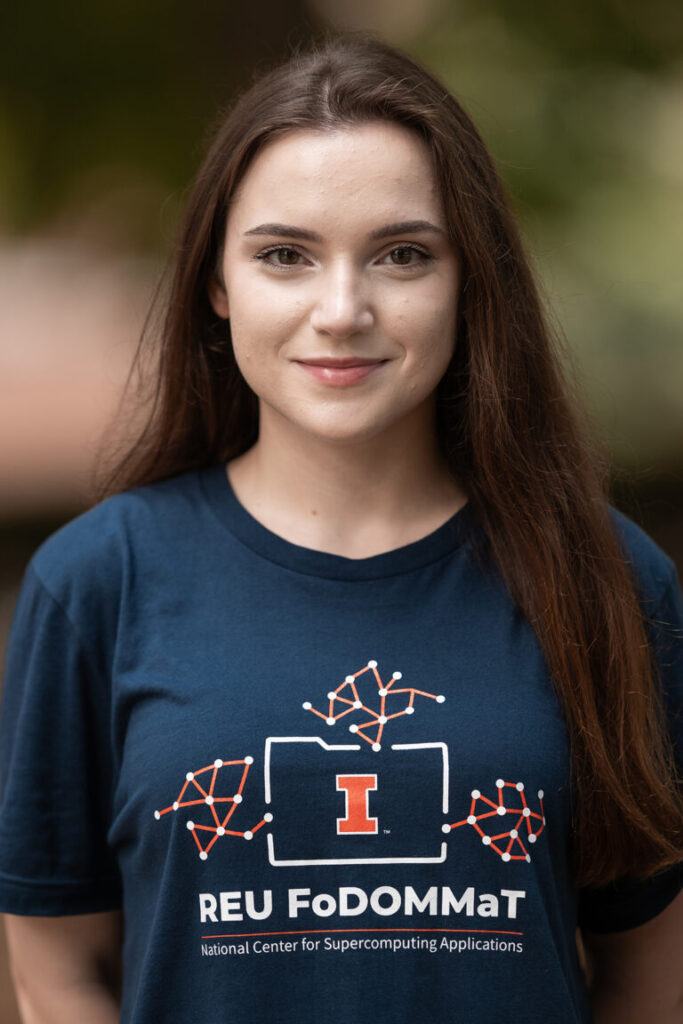
Heather Broome has had a busy year. Actively seeking research opportunities this summer, she jumped at the chance to be a part of the REU program at NCSA. She saw the potential to further her goals in the program. “I am passionate about building a future guided by ethically designed AI,” Broome said. “This path will likely be centered at the intersection of machine learning and robotics, a field that I had not been given an opportunity to experience before.”
Broome’s project could have a huge impact on next-generation manufacturing. “My project utilizes deep-learning models for end-to-end quality prediction in ultrasonic metal welding. The dataset used contains signals collected during the creation of each joint and its corresponding tensile strength. These tensile strengths were gathered using conventional quality prediction methods, which have a series of shortcomings that we hope to resolve using deep learning. The dataset was utilized by numerous pre-trained models capable of predicting the tensile strengths of new, unseen joints.”
Any manufacturing process that welds one piece of material to another could theoretically benefit from this research. If you think about all the things you use every day, much of it started as metal that needed to be welded. Chairs, cars, desks – you’ve probably used something in the last couple of hours that would have been welded at some point in the manufacturing process. “Modern joint quality prediction is destructive, expensive, time-consuming and less reliable than desired,” Broome said. “The goal of this project is to create a method for joint quality prediction that does not have such shortcomings while raising the bar for reliability.”
Broome made the most of her time within the program, speaking highly of the care in which NCSA’s REU program was designed and implemented. “The FoDOMMaT program provided me with an opportunity to learn valuable skills in both machine learning and in personal and professional development,” said Broome. “This program showed me the value of maintaining consistent effort even in the face of challenges, and it allowed me to prove my commitment to research in a way that was not possible before. Not only was I surrounded by students and mentors who shared my passion for machine learning, I was placed in the hub of cutting-edge research and leading experts. I took full advantage of the environment provided by this program and made numerous connections with outstanding researchers from a variety of fields. These relationships have significantly furthered my understanding of research, academia and professionalism, making a life-long impact on my education and career.”
The mentorship aspect of NCSA’s REU programs is just as important as matching students up with research they’re passionate about. Broome found that being a part of a team of experts was an essential part of the experience.
“I believe that Priyam Mazumdar’s contributions to this program should also be greatly noted. He was an incredible teacher and mentor for all students in the program, and I can say without a doubt that all of us were beyond grateful to have his guidance and encouragement.”
Wishing to maximize her experience while an REU fellow, Broome also explored any additional opportunities for research while she was working on her project. She discovered there were more opportunities that would gel well with her interests. “During my time at UIUC, I joined Dr. Nancy Amato’s Parasol Lab. Not only was I able to gain experience with robotics and machine learning simultaneously, but I was also able to work under the guidance of a leading innovator in the field of motion planning. The experiences and friendships I gained throughout this program are invaluable, and I cannot thank the NCSA enough for such an opportunity.”
I enjoyed being in an environment full of students who shared my passion for this field. Whenever I was challenged, I felt supported by other fellows and their commitment to pushing through similar moments of doubt or fatigue. Research is not an easy path, but the support and encouragement that surrounds FoDOMMaT fellows during their journey is irreplaceable.
Heather Broom, REU student Tweet
ALEJANDRO DUQUE
Project: Workflow Tradeoffs in the context of cancer Phylogeny
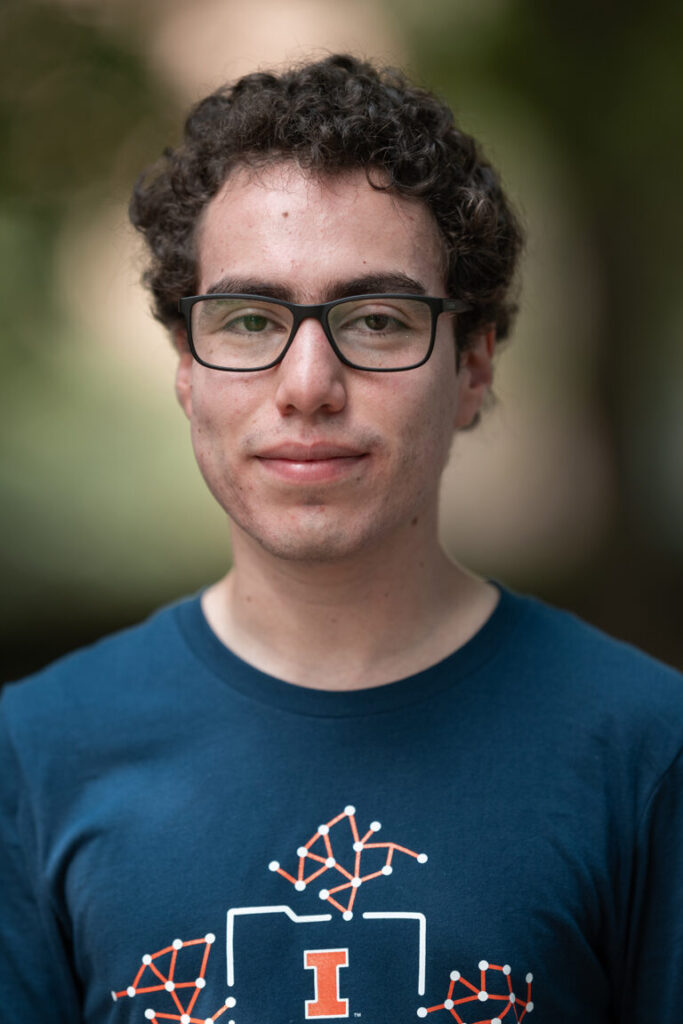
Alejandro Duque is from the Universidad San Francisco de Quito. His department selected him to participate in research at NCSA this summer in the Center’s International Research Internship Program. He was excited to be involved in a project dealing with cutting-edge technology.
“I’m researching ways to integrate modern software tools with scientific workflows,” Duque said. “Workflows are defined as computational steps applied to data to perform a certain task. I’m specifically working with Parsl, which is a Python library, and the OpenAI API. The first goal of the project is to evaluate Parsl in the field of scientific workflow definitions. The second goal is to explore ways to use AI to facilitate the use of scientific workflows.”
Duque makes no secret about what he feels is the best part of working on this research project. “The most interesting part of the project has been using the OpenAI API,” he said. “By now, everyone knows how powerful NLP models like ChatGPT are. Although their applications in software development are just emerging, I believe they could quickly revolutionize the way software is developed in the coming years.”
Like many of the REU students, Duque found the work to be challenging but rewarding. “My biggest takeaway [from the program] is that research is not linear. Sometimes you take the right path and come up with something useful. Other times you get stuck, but that’s never the end of the road. You have just discovered a way of not doing things, and that too is knowledge.”
Duque was pleased with his experience within the program, especially with how it has positioned him to take advantage of career opportunities within the research field. “This REU has given me the opportunity to have hands-on experience with state-of-the-art technology. Innovation within software development moves as fast as the tide; if you don’t go with the flow, you’ll be left behind. I think NCSA is a great place to navigate, even if your future plan, like mine, is to work in the industry as a software developer.”
In the end, it wasn’t just the knowledge and the mentorship Duque appreciated about his time in the program. His words show that these programs are more than just learning opportunities. They are a chance to meet like-minded individuals who share your passions and make new connections that you may carry with you for many years.
There’s something special about sharing a room with nine other like-minded people. It is true that everyone works on their own project, and most of the time, that is what we do in the computer lab. But every once in a while, someone says something that sparks a conversation, a plan for the weekend, or just a laugh. Those moments of serendipity are what stand out the most.
Alejandro Duque, REU student Tweet
ANNA BASKIN, SARVAGNYA VIJAY, NISHK PATEL
Project: Machine learning and Geospatial approach to targeting humanitarian assistance among syrian refugees in lebanon
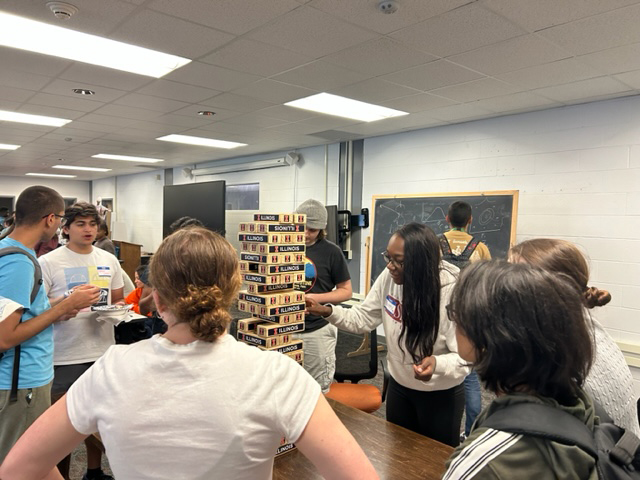
This unique collaboration was assigned students from two different student research groups, SPIN and REU FoDoMMaT. The team made up of two SPIN interns, Sarvagnya Vijay and Nishk Patel, and one REU FoDoMMaT fellow, Anna Baskin, synergized well.
The project they worked on was designed to tackle a large problem that affects millions. In February of 2022, it had already been 11 years since the Syrian refugee crisis began. More than six million Syrians were forced to flee their country. That same number again still lived within Syria but were displaced from their homes. The initial crisis drew many humanitarian groups and donations, and funds from the UN were shared with people in dire need of cash. However, in the 11 years since that time, the keen interest that spurned on those cash flows had ebbed, requiring organizations like the United Nations High Commissioner for Refugees (UNHCR) to stretch their funding. Then in February of 2022, Russia invaded Ukraine again, attempting to forcibly take the entire country. With the Ukraine refugee crisis, 17.6 million more people required aid, straining an already strained resource.
This team’s project attempts to find ways to better distribute the limited resources available to aid agencies. It’s a large task with a lot of moving parts. This team had a very specific goal within the project.
“This project identifies potential geospatial features which influence where Syrian refugees choose to settle in Lebanon using machine-learning techniques,” Vijay said, speaking on behalf of the whole group. “We extract feature data from a variety of sources, preprocess it, and run several interpretable machine-learning algorithms to find the best predictor, then generate the relative feature importance of each geospatial feature in order to identify which features have the highest impact on refugee density. Determining which features influence the geospatial distribution of refugees would enable humanitarian organizations like the United Nations to predict changing refugee populations across Lebanon, allowing for more efficient and impactful aid allocation.”
With such a large project, collaboration is key to keeping everyone on the same page. “Our most effective method of sharing project tasks has been to have a recap meeting after our standup meeting with our mentors,” said Vijay. “This is where we organize our thoughts and make sure we’re on the same page before setting a weekly goal. After that, we further divide the weekly goal into subparts and evenly distribute the work among the three of us.”
Projects assigned to fellows and interns come from a wide range of disciplines. If you’re interested in expanding your experiences and preparing for a role as a researcher post graduating, you can find information about all of NCSA’s student opportunities here.
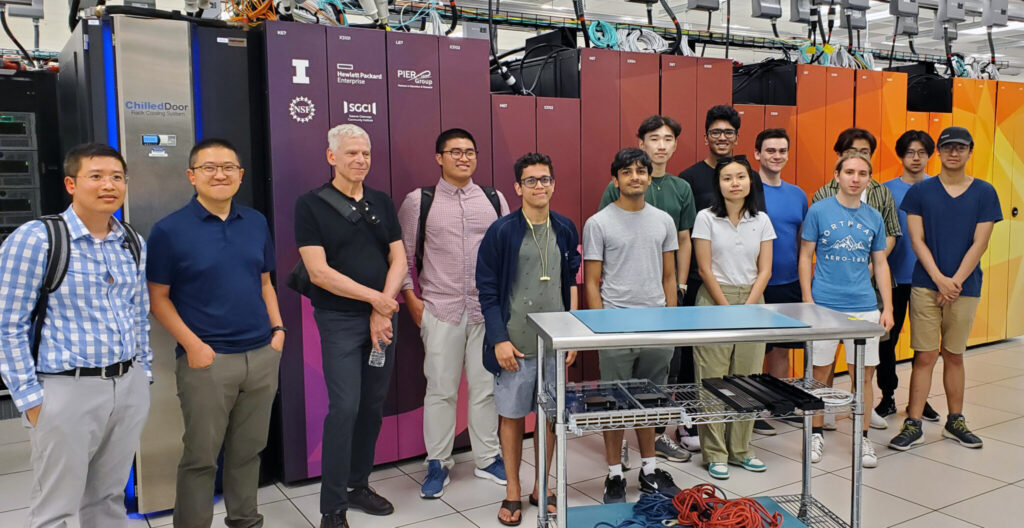
NCSA SUMMER PROGRAM RECOGNITIONS
REU FODOmMAT
SPIN
Anna Baskin
Heather Broome
Cassandra Goldberg
Tejal Kulkarni
Benjamin Lash
Jessica Liang
Chancharik Mitra
Michael Rivera
Abdullah Syed
Scott Zhao
Bach Hoang
Atharva Jain
Yichen Liu
Nishk Patel
Linh Pham
Jakub Sowa
Ashley Turner
Sarvagnya Vijay
NCSA International Research Internship Program
Alejandro Javier Duque Aguilera, USFQ, Ecuador
Visiting Scholar
Kiet Pham, NRT, Physics Ph.D. student at the University of Minnesota
Outstanding Summer Mentors
Bruno Abreu
Mohamad Alipour
Roland Haas
Matthew Krafczyk
Santiago Nunez-Corrales
Aiman Soliman
Yifang Zhang
